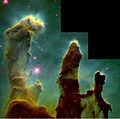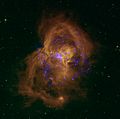Serpens facts for kids
| Constellation | |
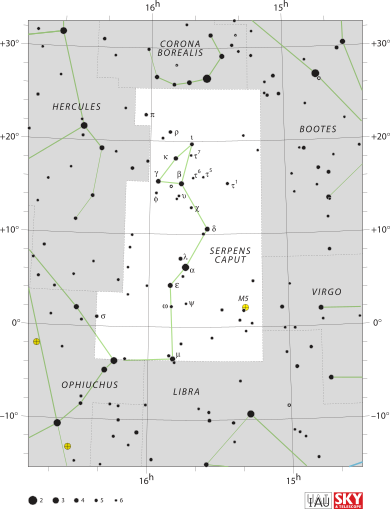 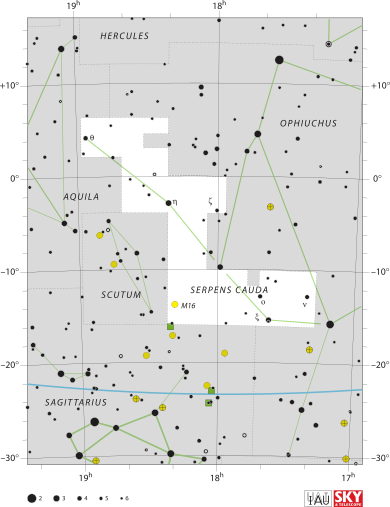 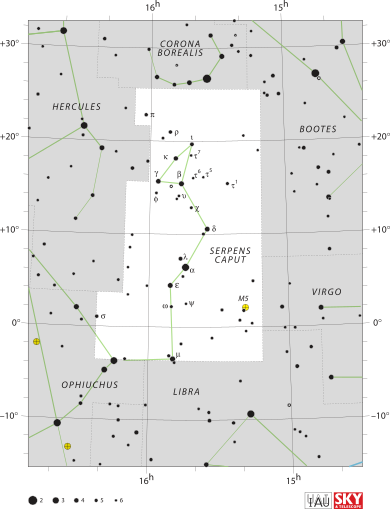
List of stars in Serpens
|
|
| Abbreviation | Ser |
|---|---|
| Genitive | Serpentis |
| Pronunciation | genitive |
| Symbolism | the Snake |
| Right ascension | Serpens Caput: 15h 10.4m to 16h 22.5m Serpens Cauda: 17h 16.9m to 18h 58.3m |
| Declination | Serpens Caput: 25.66° to -03.72° Serpens Cauda: 06.42° to -16.14° |
| Area | Serpens Caput: 428 sq. deg. Serpens Cauda: 208 sq. deg. Total: 637 sq. deg. (23rd) |
| Main stars | 11 |
| Bayer/Flamsteed stars |
57 |
| Stars with planets | 15 |
| Stars brighter than 3.00m | 1 |
| Stars within 10.00 pc (32.62 ly) | 2 |
| Brightest star | α Ser (Unukalhai) (2.63m) |
| Messier objects | 2 |
| Bordering constellations |
Serpens Caput: Corona Borealis Boötes Virgo Libra Ophiuchus Hercules Serpens Cauda: Aquila Ophiuchus Sagittarius Scutum |
| Visible at latitudes between +80° and −80°. Best visible at 21:00 (9 p.m.) during the month of July. |
|
Serpens ("the Serpent", Greek Ὄφις) is a constellation of the northern hemisphere. One of the 48 constellations listed by the 2nd-century astronomer Ptolemy, it remains one of the 88 modern constellations defined by the International Astronomical Union. It is unique among the modern constellations in being split into two non-contiguous parts, Serpens Caput (Serpent Head) to the west and Serpens Cauda (Serpent Tail) to the east. Between these two halves lies the constellation of Ophiuchus, the "Serpent-Bearer". In figurative representations, the body of the serpent is represented as passing behind Ophiuchus between Mu Serpentis in Serpens Caput and Nu Serpentis in Serpens Cauda.
The brightest star in Serpens is the red giant star Alpha Serpentis, or Unukalhai, in Serpens Caput, with an apparent magnitude of 2.63. Also located in Serpens Caput are the naked-eye globular cluster Messier 5 and the naked-eye variables R Serpentis and Tau4 Serpentis. Notable extragalactic objects include Seyfert's Sextet, one of the densest galaxy clusters known; Arp 220, the prototypical ultraluminous infrared galaxy; and Hoag's Object, the most famous of the very rare class of galaxies known as ring galaxies.
Part of the Milky Way's galactic plane passes through Serpens Cauda, which is therefore rich in galactic deep-sky objects, such as the Eagle Nebula (IC 4703) and its associated star cluster Messier 16. The nebula measures 70 light-years by 50 light-years and contains the Pillars of Creation, three dust clouds that became famous for the image taken by the Hubble Space Telescope. Other striking objects include the Red Square Nebula, one of the few objects in astronomy to take on a square shape; and Westerhout 40, a massive nearby star-forming region consisting of a molecular cloud and an H II region.
Images for kids
-
Serpens held by Ophiuchus, as depicted in Urania's Mirror, a set of constellation cards published in London c. 1825. Above the tail of the serpent is the now-obsolete constellation Taurus Poniatovii while below it is Scutum
-
Hoag's Object, a galaxy in Serpens and a member of the very rare class known as ring galaxies.
-
The Pillars of Creation, a well-known star-forming region in the Eagle Nebula made famous by this Hubble photograph
See also
 In Spanish: Serpens para niños
In Spanish: Serpens para niños





